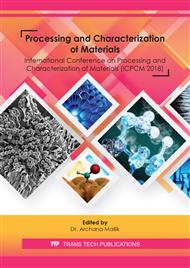[1]
M.J. Shukla, D.S. Kumar, D.K. Rathore, R.K. Prusty, B.C. Ray, An assessment of flexural performance of liquid nitrogen conditioned glass/epoxy composites with multiwalled carbon nanotube, Journal of Composite Materials. 50 (2016) 3077–3088.
DOI: 10.1177/0021998315615648
Google Scholar
[2]
I. Srikanth, S. Kumar, A. Kumar, P. Ghosal, C. Subrahmanyam, Effect of amino functionalized MWCNT on the crosslink density, fracture toughness of epoxy and mechanical properties of carbon-epoxy composites, Composites Part A: Applied Science and Manufacturing. 43 (2012) 2083–(2086).
DOI: 10.1016/j.compositesa.2012.07.005
Google Scholar
[3]
I. Scarlatescu, M. Spunei, A. Chis, S. Negru, M. Bunoiu, N. Avram, Experimental dosimetric checkup under positioning errors according to gamma criterion, UPB Scientific Bulletin, Series A: Applied Mathematics and Physics. 80 (2018) 271–280.
Google Scholar
[4]
B.C. Kim, S.W. Park, D.G. Lee, Fracture toughness of the nano-particle reinforced epoxy composite, Composite Structures. 86 (2008) 69–77.
DOI: 10.1016/j.compstruct.2008.03.005
Google Scholar
[5]
D.K. Rathore, R.K. Prusty, D.S. Kumar, B.C. Ray, Mechanical performance of CNT-filled glass fiber/epoxy composite in in-situ elevated temperature environments emphasizing the role of CNT content, Composites Part A: Applied Science and Manufacturing. 84 (2016) 364–376.
DOI: 10.1016/j.compositesa.2016.02.020
Google Scholar
[6]
R. Kumar Nayak, K. Kumar Mohata, B. Chandra Ray, Water Absorption Behavior, Mechanical and Thermal Properties of NanoTiO2 Enhanced Glass Fiber Reinforced Polymer Composites, Composites Part A: Applied Science and Manufacturing. (n.d.).
DOI: 10.1016/j.compositesa.2016.09.003
Google Scholar
[7]
K.K. Mahato, D.K. Rathore, R.K. Prusty, K. Dutta, B.C. Ray, Tensile behavior of MWCNT enhanced glass fiber reinforced polymeric composites at various crosshead speeds, IOP Conf. Ser.: Mater. Sci. Eng. 178 (2017) 012006.
DOI: 10.1088/1757-899x/178/1/012006
Google Scholar
[8]
T. Tsuda, T. Ogasawara, S.Y. Moon, K. Nakamoto, N. Takeda, Y. Shimamura, Y. Inoue, Stress transfer efficiency in aligned multi-wall carbon nanotubes sheet/epoxy composites, Composites Part A: Applied Science and Manufacturing. 67 (2014) 16–21.
DOI: 10.1016/j.compositesa.2014.07.004
Google Scholar
[9]
Q. Cheng, J. Tang, J. Ma, H. Zhang, N. Shinya, L.C. Qin, Graphene and carbon nanotube composite electrodes for supercapacitors with ultra-high energy density, Physical Chemistry Chemical Physics. 13 (2011) 17615–17624.
DOI: 10.1039/c1cp21910c
Google Scholar
[10]
M. Tian, L. Qu, X. Zhang, K. Zhang, S. Zhu, X. Guo, G. Han, X. Tang, Y. Sun, Enhanced mechanical and thermal properties of regenerated cellulose/graphene composite fibers, Carbohydrate Polymers. 111 (2014) 456–462.
DOI: 10.1016/j.carbpol.2014.05.016
Google Scholar
[11]
Z. Xu, J. Zhang, M. Shan, Y. Li, B. Li, J. Niu, B. Zhou, X. Qian, Organosilane-functionalized graphene oxide for enhanced antifouling and mechanical properties of polyvinylidene fluoride ultrafiltration membranes, Journal of Membrane Science. 458 (2014) 1–13.
DOI: 10.1016/j.memsci.2014.01.050
Google Scholar
[12]
D. Višnjić, H. Lalić, V. Dembitz, H. Banfić, Metabolism and differentiation, Periodicum Biologorum. 116 (2014) 37–43.
Google Scholar
[13]
D.R. Bortz, E.G. Heras, I. Martin-gullon, [21] Bortz elt 2011 Impressive Fatigue Life and Fracture Toughness.pdf, (2012) 238–245.
DOI: 10.1021/ma201563k
Google Scholar
[14]
M.R. Zakaria, M.H. Abdul Kudus, H. Md. Akil, M.Z. Mohd Thirmizir, Comparative study of graphene nanoparticle and multiwall carbon nanotube filled epoxy nanocomposites based on mechanical, thermal and dielectric properties, Composites Part B: Engineering. 119 (2017) 57–66.
DOI: 10.1016/j.compositesb.2017.03.023
Google Scholar
[15]
G.V. Seretis, G. Kouzilos, D.E. Manolakos, C.G. Provatidis, On the graphene nanoplatelets reinforcement of hand lay-up glass fabric/epoxy laminated composites, Composites Part B: Engineering. 118 (2017) 26–32.
DOI: 10.1016/j.compositesb.2017.03.015
Google Scholar
[16]
S. Chatterjee, F. Nafezarefi, N.H. Tai, L. Schlagenhauf, F.A. Nüesch, B.T.T. Chu, Size and synergy effects of nanofiller hybrids including graphene nanoplatelets and carbon nanotubes in mechanical properties of epoxy composites, Carbon. 50 (2012) 5380–5386.
DOI: 10.1016/j.carbon.2012.07.021
Google Scholar
[17]
D.S. Kumar, M.J. Shukla, K.K. Mahato, D.K. Rathore, R.K. Prusty, B.C. Ray, Effect of post-curing on thermal and mechanical behavior of GFRP composites, in: IOP Conference Series: Materials Science and Engineering, IOP Publishing, 2015: p.012012.
DOI: 10.1088/1757-899x/75/1/012012
Google Scholar
[18]
S.K. Ghosh, P. Rajesh, B. Srikavya, D.K. Rathore, R.K. Prusty, B.C. Ray, Creep behaviour prediction of multi-layer graphene embedded glass fiber/epoxy composites using time-temperature superposition principle, Composites Part A: Applied Science and Manufacturing. 107 (2018) 507–518.
DOI: 10.1016/j.compositesa.2018.01.030
Google Scholar
[19]
C. Kostagiannakopoulou, X. Tsilimigkra, G. Sotiriadis, V. Kostopoulos, Synergy effect of carbon nano-fillers on the fracture toughness of structural composites, Composites Part B: Engineering. 129 (2017) 18–25.
DOI: 10.1016/j.compositesb.2017.07.012
Google Scholar
[20]
A.A. Moosa, A.R.S. A, F. Abdul, K. Kubba, M. Raad, Synergetic Effects of Graphene and Nonfunctionalized Carbon Nanotubes Hybrid Reinforced Epoxy Matrix on Mechanical , Thermal and Wettability Properties of Nanocomposites, 7 (2017) 1–11.
Google Scholar
[21]
G. Tsagaropoulos, A. Eisenberg, Dynamic Mechanical Study of the Factors Affecting the Two Glass Transition Behavior of Filled Polymers. Similarities and Differences with Random Ionomers, Macromolecules. 28 (1995) 6067–6077.
DOI: 10.1021/ma00122a011
Google Scholar


